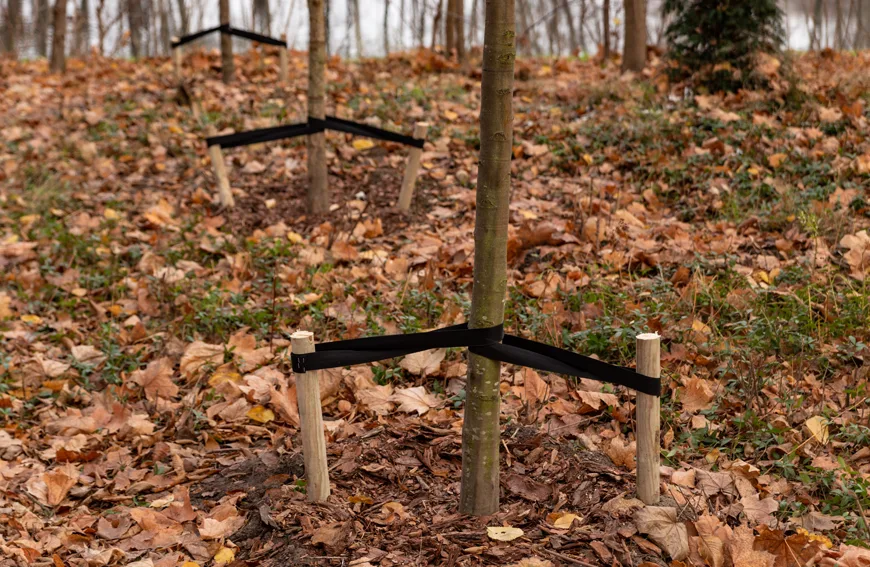Tree support systems have come a long way. Gone are the days when rigid rods and heavy steel cables were the only way to stabilize a weakened tree. Today, dynamic tree bracing offers a smarter, more biologically sensitive solution — one that supports trees while respecting how they grow and move. In this post, we’ll dive into what dynamic bracing is, why it’s so transformational for tree health, and when it’s the right choice for your landscape.
The Challenge with Traditional Tree Bracing
Many older support systems relied on inflexible tools: steel rods drilled through unions or steel cables locked tightly across branches. While these methods provided immediate reinforcement, they didn’t allow the tree to move naturally. This restricted movement can actually hinder a tree’s long-term strength — by preventing the natural flexing that stimulates internal growth.
Over time, arboriculture has evolved. Experts now understand that a tree’s natural swaying (even in gentle breezes) triggers vital biological responses: the formation of reaction wood, a stronger vascular system, and a deeper, more resilient root network. A rigid brace may “solve” an immediate issue, but it can interfere with these essential developmental processes.
What Is Dynamic Tree Bracing?
Dynamic tree bracing is a modern arboricultural technique that blends engineering with biology. Rather than locking a tree in place, a dynamic system uses materials that stretch and absorb shock. The goal: allow the tree to move in a controlled way while still offering protection when forces, like strong wind or heavy snow, become risky.
Key components typically include:
- High-strength synthetic ropes or cables that have elastic or stretchable properties
- Shock-absorbing elements that dissipate energy when stress increases
- Specialized attachments that adapt to the tree’s changing structure as it grows
- Protective materials that minimize damage to the bark and living tissues
By giving the tree room to sway and react, these systems encourage natural strengthening — while intervening just enough during peak stress events to prevent structural failure.
Why Trees Need to Move: The Biology of Bracing
Movement is essential for a tree’s health. Through a process called thigmomorphogenesis, trees sense mechanical stress (like wind) and respond by reinforcing themselves. Here’s how dynamic bracing helps support that:
- Trunk taper development: A trunk that experiences gentle, regular motion often grows with a more natural, tapered profile, making it stronger where it matters most.
- Reaction wood formation: When branches flex, trees produce specialized wood (reaction wood) that reinforces weak areas.
- Root reinforcement: Subtle motion encourages the roots to anchor more broadly, improving stability.
- Healthier vascular tissues: Trees that sway gently often develop a more robust internal transport system, which helps them heal and thrive.
Dynamic bracing systems don’t stop these processes — they support them. They work with the tree’s biology instead of fighting it.
The Benefits of Dynamic Bracing
Structural Stability That Respects Growth
Unlike rigid braces, dynamic systems provide structural support only when needed. During calm conditions, the tree is free to move. But when stress increases — say during a storm — the system tightens and provides extra reinforcement. This keeps forces from concentrating in vulnerable parts of the tree and allows other sections to absorb and distribute load more effectively.
Energy Absorption During Extreme Conditions
Dynamic bracing isn’t just about flexibility — it’s about energy management. With built-in shock absorbers, these systems can dissipate the energy generated by wind gusts, ice, or snow. This means that instead of resisting suddenly, the brace gradually engages, reducing the risk of a limb or union snapping.
Long-Term Health & Longevity
Because dynamic bracing allows for controlled movement, trees don’t develop the problems often caused by being held rigidly: restricted growth, impaired wound healing, and compensatory growth. Over time, these systems help trees build resilience naturally, potentially extending their lifespans.
Aesthetics & Minimal Intrusion
Dynamic systems are generally less visually intrusive. Synthetic ropes are more discreet than thick steel cables, and modern attachment hardware is designed to minimize visible damage to the bark. This not only preserves the look of the tree, but respects its natural form.
When Is Dynamic Bracing Appropriate?
Dynamic bracing is not a one-size-fits-all solution. But there are several scenarios where it’s especially effective:
- Trees with structural defects such as cracks, weak unions, or included bark
- Multi-stem or co-dominant trees where the risk of splitting is high
- Specimen or heritage trees that are valuable and worth preserving
- Trees in exposed locations, where wind or weather regularly stresses the structure
- Young to middle-aged trees that have the capacity to adapt and strengthen over time
Before recommending a system, a qualified arborist should conduct a comprehensive risk assessment. This typically includes:
- Evaluating the likelihood and consequences of failure (risk assessment)
- Identifying precise areas of weakness or failure potential
- Assessing overall tree health to ensure it can handle bracing
- Examining the site and environmental factors such as wind exposure
- Deciding on the best configuration for cabling and bracing
How a Dynamic Bracing System Is Installed
The success of dynamic bracing relies heavily on professional installation and maintenance. Here’s a typical approach:
- Material selection: Use of synthetic ropes or cables (such as systems like Cobra® or TreeSave®) that offer stretch and UV resistance.
- Positioning: Components are usually placed about two-thirds up from the base of the defect (for example, measured from a weak union to the top of the canopy).
- Mounting tactfully: Hardware and straps are positioned to avoid drilling wherever possible. This preserves the tree’s integrity.
- Tensioning: The system is tensioned just right — loose enough to allow movement, yet ready to absorb load.
- Testing: Once installed, the system is tested to ensure all elements work correctly and safely.
- Documentation: Detailed records are kept, including installation specs and plans for follow-up.
Maintenance Matters: Long-Term Care for Dynamic Systems
Installing a system is only half the job. To maintain optimal performance, regular maintenance is essential:
- Annual inspections to check the integrity of ropes, shock absorbers, and hardware
- Tension adjustments as trees grow or as components settle
- Component replacement for parts showing wear, UV damage, or fatigue
- Expansion or reconfiguration if the tree’s architecture changes significantly
- Record keeping to document changes, inspections, and upgrades
Professional arborists trained to work with dynamic bracing are crucial for safe, effective long-term tree care.
Comparing Dynamic and Static Bracing
Here’s how these two philosophies differ in application and impact:
Dynamic Bracing:
- Works with the tree, not against it.
- Engages only under stress, allowing natural movement otherwise.
- Encourages reaction wood and healthy growth.
- Installation can often avoid drilling.
- Requires periodic tensioning but can last many years with proper maintenance.
Static Bracing (traditional):
- Provides rigid, constant support.
- Restricts natural movement, which can limit a tree’s own strengthening responses.
- Often involves drilling rods through limbs or the trunk.
- May require frequent adjustment or repair.
- May impair tissue over time, particularly if not installed sensitively.
Choosing between these systems depends on many factors: the tree’s species, age, defect type, and its role in the landscape. It also depends on the goals: is preservation the priority, or stability above all?
The Investment in Tree Health
Dynamic bracing is not cheap — but for the right tree, it can be a very wise long-term investment. Costs vary depending on the complexity of the system, the size of the tree, and accessibility. While dynamic systems might demand annual inspections and occasional component replacement, the benefits often outweigh the costs: reduced risk, longer lifespan, and safer, healthier trees.
High-quality synthetic systems often last 7 to 10 years or more before major parts need replacement. Elastomeric shock absorbers might be good for 5–8 years, depending on exposure, while protective sleeves or other coverings may require replacement every few years. But with proper care and monitoring, these systems can pay off in resilience and longevity.
Is Dynamic Bracing Right for Your Trees?
You might want to contact a certified arborist if you notice:
- Cracks or splits in major unions
- Weakly attached stems or co-dominant trunks
- Leaning trees or evidence of root lifting
- Branches that have partially failed but are still valuable
- A tree that’s historically or sentimentally important and you want it to live
- A risk assessment confirming potential hazards but offering preservation options
Certified arborists with specific training in dynamic systems can evaluate your tree’s needs, propose a tailored bracing plan, and handle installation and maintenance professionally.
How Five Star Tree Services Can Help
At Five Star Tree Services, we’re committed to the long-term health and safety of your trees. Our ISA-certified arborists are experienced in both static and dynamic support systems. We’ll work with you to:
- Assess your tree’s risk and structural condition
- Recommend a support solution that respects both safety and biology
- Install dynamic bracing systems with minimal intrusion
- Provide regular follow-up inspections and adjustments
- Educate you on maintenance and expected service life
Preserving a damaged or vulnerable tree isn’t just about preventing failure — it’s about giving the tree a chance to strengthen itself, heal properly, and thrive for years to come.


